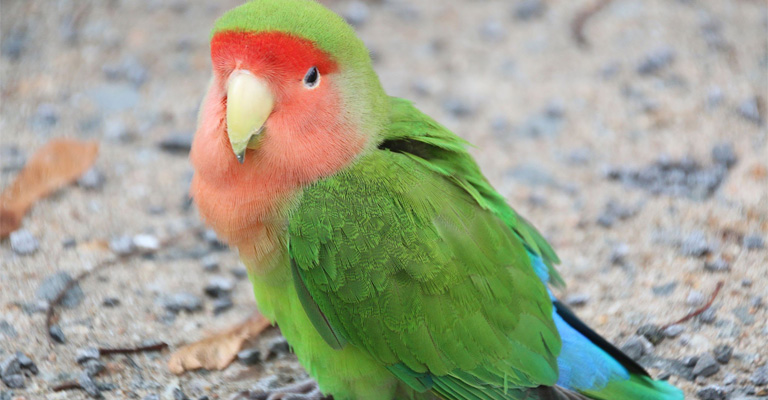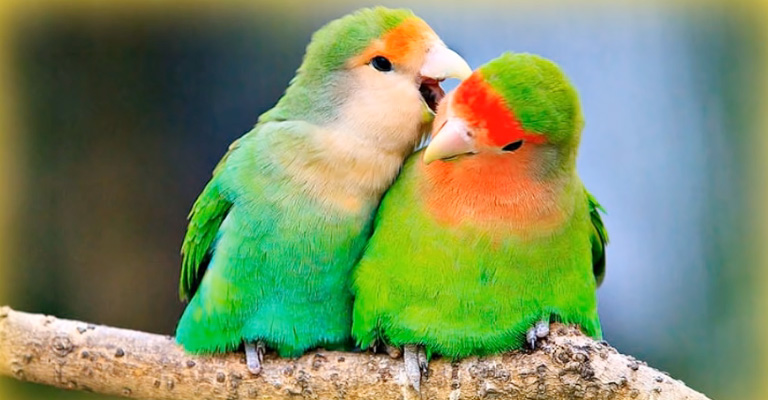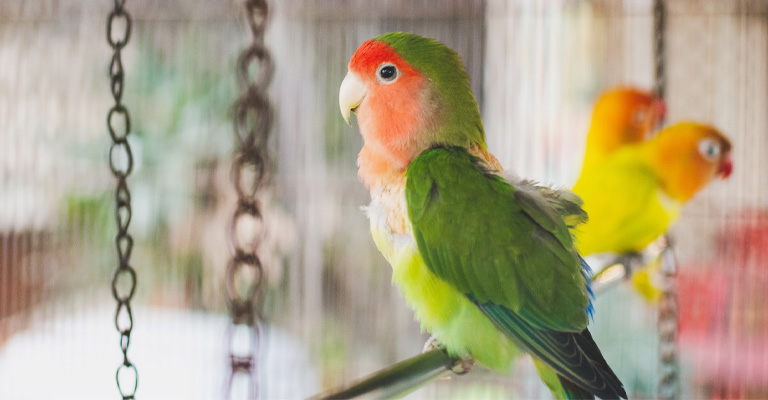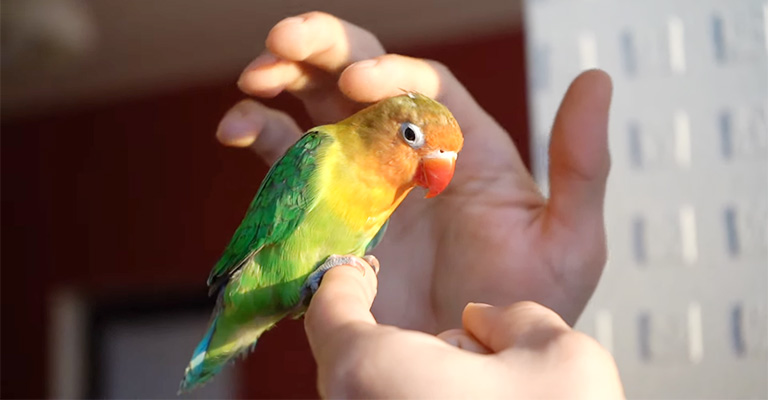Lovebirds, those charming and affectionate parrots, have captured the hearts of bird enthusiasts worldwide. While they are known for their lively personalities and strong bonds with their human companions, one question often surfaces: Can lovebirds talk?
In this blog post, we will delve into the fascinating world of lovebird communication to unravel the truth behind this popular inquiry.
Lovebirds, unlike larger parrot species, have unique characteristics that influence their vocal abilities. Their smaller beaks and vocal apparatus limit their capacity for mimicking human speech, yet they possess a remarkable repertoire of natural sounds.
From melodious chirps to joyful whistles, lovebirds have their distinctive ways of expressing emotions, bonding with their mates, and communicating with their flock.
In the following sections, we’ll explore the science behind lovebird vocalizations, discuss the potential for training them to mimic sounds, and shed light on the significance of social interaction in enhancing their communication skills.

Do Lovebirds Talk?
Lovebirds are known for their affectionate behavior and strong bond with their mates, but they don’t talk in the way humans do. Unlike parrots, which can mimic human speech, lovebirds primarily communicate through chirps, whistles, and body language.
They use vocalizations to express their feelings, convey moods, and communicate with their flock or mate. While they may not mimic words, lovebirds can develop unique vocalizations or sounds that are specific to them and their environment.
These sounds serve as a form of communication among lovebirds and help them bond with their partners. So, while lovebirds don’t talk like humans, they do have their own charming way of expressing themselves and connecting with their fellow feathered companions.
The Myth of Lovebirds Talking
Lovebirds, small and colorful parrots known for their affectionate behavior, have often been subject to a common misconception: the belief that they can talk like larger parrot species such as African Greys or Amazon parrots.
However, this belief is a myth, and it’s essential to debunk it to better understand lovebirds and their communication abilities. Here’s why lovebirds don’t talk:
Anatomy
Lovebirds have smaller beaks and a different vocal apparatus compared to larger parrot species. Their physical structure limits their ability to mimic human speech accurately.
While they can produce chirps, whistles, and squawks, their vocal range is not suited for imitating words and phrases.
Lack of Mimicry Skills
Lovebirds do not possess the same level of mimicry skills as some larger parrot species known for their talking abilities. Parrots that can talk often have an innate ability to mimic sounds, including human speech, whereas lovebirds primarily communicate using their natural vocalizations.
Natural Communication
Lovebirds communicate with their flock or mate primarily through a series of chirps, squawks, and body language. These vocalizations convey their emotions, and needs, and establish social bonds within their group. They have no evolutionary need to mimic human speech.
Individual Vocalizations
While lovebirds may not talk like humans, they can develop unique vocalizations specific to them. Each lovebird can have its distinct sounds and calls, helping them identify each other within their group or mate.
Bonding and Expressing Emotions
Lovebirds use their vocalizations to express affection, alert others to danger, or communicate their moods. Their unique sounds are a crucial part of their bonding and social interactions, making them even more endearing as pets.
Potential for Training
While lovebirds may not talk naturally, some individuals can be trained to mimic simple sounds or whistles. However, this training requires patience, and consistency, and may not result in full-fledged human speech.
Lovebirds do not talk like humans due to their physical limitations, natural communication methods, and lack of mimicry skills. Instead, they use their vocalizations to communicate with their flock or mate and establish strong social bonds.
While lovebirds may not be the best choice for those seeking a talking parrot, their unique and charming sounds make them wonderful companions in their own right.
Understanding and appreciating their natural communication methods can lead to a deeper connection with these delightful birds.
Lovebirds’ Natural Sounds

Lovebirds are known for their delightful and expressive natural sounds. These sounds play a crucial role in their communication, social interactions, and bonding within their flock or with their mate.
Here are some of the common natural sounds made by lovebirds:
Chirping
Lovebirds are prolific chirpers. They produce a variety of chirping sounds that can convey different emotions and messages. Soft, rapid chirps often indicate contentment or excitement, while louder and more insistent chirps might signal alarm or a desire for attention.
Whistling
Lovebirds are capable of producing melodious whistles. They may use whistling to communicate with their mate or simply as a way to express happiness. These whistles can vary in pitch and tone among individual birds.
Squawking
Lovebirds can be quite vocal, especially when they are trying to get their point across. Squawking is often a louder and more insistent sound, typically used when they are excited, agitated, or want something urgently.
Purring
Lovebirds can produce a soft, purring sound, especially when they are content and relaxed. This gentle sound is a sign of comfort and a peaceful state of mind.
Clicking
Lovebirds might make clicking sounds when they are exploring their environment, interacting with objects, or investigating something new. This behavior is often seen during playtime.
Mimicking Sounds
While lovebirds do not naturally mimic human speech, some individuals may pick up on household noises or sounds from their environment.
This can include the beeping of appliances, ringing phones, or even the sound of a creaking door. However, their mimicry tends to be less precise compared to larger parrot species.
Courtship Sounds
Lovebirds are known for their affectionate courtship rituals. During courtship, they may engage in mutual preening and make soft, cooing sounds to express their love and strengthen their bond.
Alarm Calls
Lovebirds are vigilant birds, and they use specific vocalizations to alert their flock members to potential threats. These alarm calls are louder and more urgent, serving as a warning to others to be on guard.
Contact Calls
When lovebirds are separated from their mate or flock members, they may use contact calls to stay in touch. These calls help them maintain contact and ensure they can find each other when needed.
Understanding these natural sounds is essential for lovebird owners, as it allows them to interpret their pets’ emotions and needs better.
Building a strong bond with lovebirds involves recognizing and responding to their unique vocalizations, which can lead to a deeper and more fulfilling relationship with these charming birds.
Can Lovebirds Mimic Human Speech?

Lovebirds are not known for their ability to mimic human speech to the same extent as some larger parrot species, such as African Greys, Amazons, or budgerigars (budgies).
Lovebirds have smaller vocal apparatuses and less developed mimicry skills compared to these larger parrots. As a result, their capacity for imitating human speech is quite limited.
However, it’s important to note that individual lovebirds can vary in their abilities and behavior. While it is rare, some lovebirds may pick up on a few simple words or phrases with repeated exposure to human speech.
These instances of mimicry are typically less clear and precise compared to the mimicry exhibited by larger parrots.
If you are interested in teaching your lovebird to mimic sounds or words, here are some considerations:
- Patience and Consistency: Teaching a lovebird to mimic sounds or words requires a significant amount of patience and consistency. Repetition and positive reinforcement are key.
- Start Early: Younger lovebirds may be more receptive to learning new sounds, so it’s often easier to teach them when they are still in their juvenile stage.
- Choose Simple Words: Begin with simple and short words or phrases. Lovebirds are more likely to mimic basic sounds than complex sentences.
- Use Positive Reinforcement: Reward your lovebird with treats or praise when they make attempts to mimic sounds or words correctly.
- Respect Their Limits: Keep in mind that not all lovebirds will be interested or capable of mimicking human speech. Respect your bird’s individual personality and abilities.
Remember that lovebirds are charming and affectionate companions, even without the ability to mimic speech. They have their unique ways of communicating through natural sounds, body language, and bonding behaviors.
If you’re looking for a parrot species that is more renowned for talking, you might consider other options like African Greys or Amazon parrots, which are known for their impressive mimicry skills.
The Importance of Social Interaction to Make Lovebirds Communicate with Human

Social interaction is vital when it comes to fostering communication between lovebirds and humans. Lovebirds are social birds by nature, and they thrive on interaction and companionship.
Establishing a strong bond through social interaction not only enhances the well-being of your lovebirds but also increases the likelihood of them being more communicative with you.
Here’s why social interaction is crucial:
Building Trust
Social interaction helps build trust between lovebirds and their human caregivers. Trust is the foundation of a positive relationship and effective communication. When lovebirds feel safe and secure in your presence, they are more likely to engage with you.
Learning from Observation
Lovebirds are excellent observers. When they have regular interactions with humans, they can learn from observing your behavior, including how you communicate and react to various situations. This observational learning can influence their own communication patterns.
Imprinting
Lovebirds, especially when hand-raised from a young age, can form a strong attachment to their human caregivers. This imprinting can lead to increased social interaction and communication as they see you as a part of their flock.
Verbal and Non-Verbal Cues
Through social interaction, lovebirds can pick up on both verbal and non-verbal cues from their human companions. They learn to interpret your body language, facial expressions, and tone of voice, which can contribute to more effective communication.
Mimicking Sounds
Although lovebirds are not known for extensive speech, some individuals may be more likely to mimic sounds, including human speech, when they are exposed to it regularly through social interaction. They may pick up on words or phrases used frequently in their environment.
Expressing Emotions
Social interaction provides a platform for lovebirds to express their emotions and needs. They may use vocalizations, body language, and gestures to convey their feelings, whether it’s excitement, affection, or a desire for attention.
Bonding
Lovebirds are highly social within their flock, and they seek companionship and bonding. When they form a strong bond with their human caregivers through social interaction, they are more likely to engage in various forms of communication to maintain that bond.
Enrichment
Interacting with humans can provide mental and emotional stimulation for lovebirds. Enrichment activities, such as toys, games, and positive interactions, can keep them engaged and content, encouraging more communication.
To maximize social interaction with your lovebirds, spend quality time with them daily. This can include talking to them, offering treats, providing toys for mental stimulation, and engaging in gentle physical interaction like petting and scratching.
Remember to be patient and allow your lovebirds to initiate interaction, as they may have different preferences for socializing.
Building a strong and positive relationship through social interaction can lead to a deeper understanding and better communication between you and your lovebirds.
Training Lovebirds to Mimic Sounds
Training lovebirds to mimic sounds, including human speech or specific noises, can be a rewarding and fun experience.
While lovebirds are not as renowned for their mimicry abilities as some other parrot species, with patience and consistent training, some individuals can learn to imitate sounds to varying degrees.
Here’s a step-by-step guide on how to train lovebirds to mimic sounds:
Start with a Quiet Environment
Ensure you have a calm and quiet training environment, free from distractions, so your lovebird can focus on the training sessions.
Choose Simple Sounds
Begin with simple and distinct sounds that are easy for your lovebird to mimic. Start with short words or phrases, whistles, or common household sounds like doorbells or phone ringtones.
Repetition is Key
Repetition is crucial in teaching lovebirds to mimic sounds. Repeatedly play the sound you want them to learn in their presence. You can use a recording or imitate the sound yourself.
Positive Reinforcement
Reward your lovebird with treats, praise, or affection whenever they make an attempt to mimic the sound correctly. Positive reinforcement encourages them to continue trying.
Use Consistent Phrasing
When teaching words or phrases, use the same phrasing each time. Consistency helps your lovebird associate specific sounds with particular meanings.
Be Patient
Some lovebirds may pick up sounds quickly, while others may take more time. Be patient and understanding of your bird’s individual learning pace. Avoid getting frustrated or raising your voice.
Limit Training Time
Keep training sessions short and frequent, usually around 10-15 minutes a few times a day. Overloading your lovebird with training can be counterproductive.
Model the Sound
If possible, demonstrate the sound yourself, and encourage your lovebird to mimic your actions and sounds.
Create Associations
Associate the sound with actions or events. For example, if you want your lovebird to mimic the sound of a bell, ring the bell when offering a treat. This helps your bird connect the sound with a reward.
Provide Interactive Toys
Toys that produce sounds can also be helpful in encouraging mimicry. For instance, a toy that makes a specific noise when manipulated by your lovebird can pique their interest in mimicking that sound.
Monitor Progress
Keep track of your lovebird’s progress in a journal. Note which sounds they respond to positively and work on those more intensively.
Be Mindful of Stress
Always prioritize your lovebird’s well-being. If the training seems to stress them out or cause anxiety, take a break and try again later. Training should be a positive and enjoyable experience for both you and your bird.
Remember that not all lovebirds will successfully mimic sounds, and some individuals may be more inclined to do so than others. It’s essential to respect your bird’s limitations and personality.
Even if your lovebird doesn’t become a master mimic, the training process can still be a fantastic bonding experience that enhances your relationship.
FAQs
Can lovebirds talk like parrots?
No, lovebirds cannot talk like parrots such as African Greys or Amazons. Lovebirds have smaller vocal apparatuses and limited mimicry skills, making them less capable of imitating human speech. They primarily communicate using their natural sounds like chirps, whistles, and squawks.
Can all lovebirds mimic sounds to some extent?
While some lovebirds may mimic simple sounds or words, not all have the same abilities. Individual variation exists, and some lovebirds may be more inclined to mimic sounds than others. Training and patience are key factors in determining a lovebird’s mimicry skills.
How can I teach my lovebird to talk?
Teaching lovebirds to talk can be challenging but not impossible. Start with short, simple words or phrases, use consistent phrasing, and provide rewards for their efforts. Be patient, repeat sounds regularly, and maintain a quiet training environment to encourage your lovebird’s learning.
Are male lovebirds more likely to talk than females?
There is no significant gender-based difference in the ability to mimic sounds or talk among lovebirds. Both male and female lovebirds can potentially learn to mimic sounds to varying degrees. The capacity to talk depends more on individual personality and training efforts.
What are the primary ways lovebirds communicate if they don’t talk?
Lovebirds communicate primarily through natural sounds like chirping, whistling, and squawking. They use these vocalizations to express emotions, convey messages to their flock or mate, and establish social bonds.
Additionally, they rely on body language, gestures, and interactive behaviors to communicate effectively.
Wrapping Up
While lovebirds may not talk like their larger parrot counterparts, they communicate in their enchanting, unique way. Their natural sounds and expressive behaviors are a testament to their social nature and their strong bonds with both their avian companions and humans.
Understanding and appreciating the rich language of lovebirds can lead to a deeper connection and a more fulfilling relationship with these delightful feathered friends.
So, even if they don’t speak human words, lovebirds certainly have a lot to say in their own charming language, and it’s a joy to listen and respond to their delightful sounds.